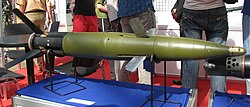This article needs additional citations for verification. (September 2023) |
| Krasnopol | |
|---|---|
 30F39 Krasnopol guided projectile | |
| Type | Guided artillery shell |
| Place of origin | Soviet Union/Russia |
| Service history | |
| In service | 1986–present |
| Used by | Soviet Army Russian Army Syrian Arab Army Indian Army |
| Wars | |
| Production history | |
| Manufacturer | KBP Instrument Design Bureau |
| Produced | 1986–present[6] |
| Variants | 2K25 Krasnopol 2K25M Krasnopol-M K155M Krasnopol-M2 Krasnopol-d |
| Specifications | |
| Mass | 50 kg (110 lb) K155M: 54 kg (119 lb)[7] |
| Length | 1,300 mm (51 in)[7] |
| Diameter | 152 mm and 155 mm |
| Caliber | 152 mm and 155 mm |
| Effective firing range | Krasnopol: 20 km (12 mi)[8] K155M: 25 km (16 mi)[9] Krasnopol-D: 43 km (27 mi) (with 2S19 gun) or 60 km (37 mi) (with 2S35 gun)[10] |
| Warhead | High explosive |
| Warhead weight | Krasnopol: 6.50 kg (14.33 lb)[11] Krasnopol-M: 11.00 kg (24.25 lb)[citation needed] K155M: 11 kg (24 lb)[7] |
Guidance system | Laser guidance K155M: GLONASS-GPS, Semi-active laser homing[7] |
The 2K25 Krasnopol[12][13][14] is a Soviet 152/155 mm cannon-launched, fin-stabilized, base bleed-assisted, semi-automatic laser-guided artillery weapon system. It automatically 'homes' on a point illuminated by a laser designator, typically operated by a drone or ground-based artillery observer. Krasnopol projectiles are fired mainly from Soviet self-propelled howitzers such as the 2S3 Akatsiya and 2S19 Msta-S and are intended to engage small ground targets such as tanks, other direct fire weapons, strong-points, or other significant point targets visible to the observer. It can be used against both stationary and moving targets (providing these remain within the observer's field of view).
- ^ "Artillery: "One Shot, One Kill" May Not be Worth It".
- ^ "Russia Now Using Guided Artillery Shells Against Syrian Militants". 20 August 2016. Retrieved 4 July 2018.
- ^ "Russian military eliminates militants who shelled Hmeymim airbase December 31". TASS. 12 January 2017. Retrieved 4 July 2018.
- ^ Yuri Lyamin; N.R. Jenzen-Jones (10 November 2017). "Chinese GP1 series guided artillery projectiles in Libya". The Hoplite. Armament Research Services. Retrieved 4 July 2018.
- ^ "Russian army destroys Ukraine's S-300 system with smart artillery shell — military". tass.com. 2022-03-24.
"An unmanned aerial vehicle identified the position of a Ukrainian air defense system, which was attacked with a smart artillery shell Krasnopol. The shell was targeted by a laser-equipped drone," the Defense Ministry said.
- ^ "ЦАМТО / / "Калашников" завершил поставки "Краснополь-М2"". armstrade.org (in Russian). 2023-12-27. Retrieved 2023-12-28.
- ^ a b c d "Krasnopol-M2 155-mm shell with semi-active laser guidance". Archived from the original on 2022-07-08.
- ^ "2K25". Retrieved 4 July 2018.
- ^ "155mm "Krasnopol-M2" artillery guided weapon system KM-1M". roe.ru. Retrieved 2023-07-12.
- ^ "Long-range "Krasnopol-D" in artillery duels with Western SAU. Can we expect triumph".
- ^ "Threat Update Krasnopol--A Laser-Guided Projectile for Tube Artillery". fas.org. Retrieved 4 December 2019.
- ^ Krasnopol-M2 Retrieved 4 July 2018.
- ^ International Electronic Countermeasures Handbook. Horizon House. 2004. ISBN 9781580538985. ISSN 1091-9422.
- ^ "Krasnopol, Kitolov Precision Guided Artillery Munition". Defense Update. 26 January 2005. Retrieved 4 July 2018.